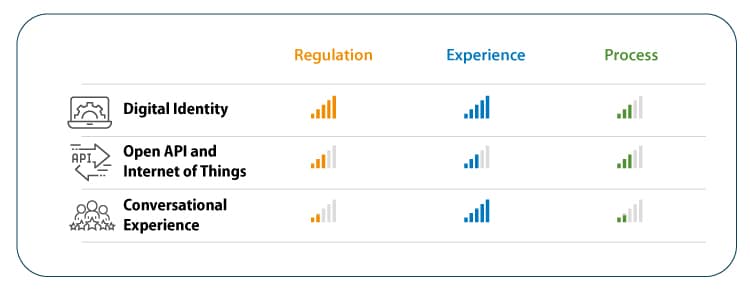Asia Pacific journeys into reimagination

Ethan Wang
Product Manager, Infosys FinacleDownload FinacleConnect Download Article
One of the most loved brands in the world, Disney, has always embodied the concept of “customer journeys”. Especially at its exquisitely designed theme parks. Recently, with the use of digital technologies such as digital bands that help contextualize every moment visitors spend at a park, the brand has notched up its customer-centricity quotient and become emblematic of data-driven designled customer experience delivery.
“Digital customer journey” is the underlying thinking behind the relevant and contextual omni-channel experiences that all businesses are striving to weave today, including banking.
Redefining digital customer journey
The art of designing great customer journeys begins with persona building and is a continuous process of gauging, anticipating and understanding a customer’s motivations, feelings, emotions and goals thereafter, at every touchpoint and interaction. The success of a customer journey lies in the extent of contextualization, and hence the value it creates for the recipient. The good news is that the pursuit of contextualization is not a blindfolded chase in the dark, but powered by technology enablers such as Big Data that continuously serve to hone the craft. The catch, however, lies in designing workflows and processes that maximize the potential of customer insights and data across entire digital journeys and see the customers through to completion of a desired goal.
All customer journeys in banking can be atomized in four clear stages. The journey begins with identification, progresses through a set of touchpoints spanning a variety of interactions to get to the final point of administering a service.
In Asia Pacific, three key trends across four elements – identity, touchpoints, interactions, and service – are shaping the customer journey transformation efforts of banks.
The following diagram illustrates the three key trends and the extent of their impact in the areas of regulation, customer experience, and process.
1. Digital identity: the key to a customer-centric journey
All kind of digital information about an entity constitutes its digital identity. For a bank’s customer, mobile, email, digital record of identity or biometric information can serve as their digital identity. Digital identity is fast gaining acceptance and application in the identification part of the value-chain. A common digital identity system among participants of a trusted network can help eliminate time consuming paper intensive identification process that requires physical presence and interaction between a bank and a customer.
Regulatory policies in different countries in the region are aligning their policies and mandates to enable direct onboarding with digital identity (See Table 1). An example is Aadhar-based identification in India. The country’s banking regulator, Reserve Bank of India (RBI) has allowed digital customer onboarding with the use of the unique identity number or Aadhar, in a major move to significantly simplify customer onboarding. In Singapore, the government has introduced the MyInfo digital identity service. Banks in Singapore are revamping their onboarding experience with the use of MyInfo database.
Progressive banks that have already launched digital direct onboarding services in the region are now redesigning their CRM (customer relationship management) and CIF (customer information and profile) systems to capitalize on the benefits of digital identity for greater customer-centricity and frictionless customer experience.
2. Open APIs and IoT to embrace the digital ecosystem with frictionless experience
The proliferation of touch points for transactions and banking services combined with the rise of Open APIs is driving three key trends. Firstly, a sizeable number of customer service interactions are now originating on non-banking touchpoints. A study by ICICI Bank predicts that as many as 50% of the total number of transactions that today take place on bank-owned channels globally will move to non-banking channels by as early as 2022. Banking transactions will originate and be influenced on non-banking channels. Scenarios such as an insurance application getting initiated on a travel platform, application for an unsecured loan originating on an e-commerce website or a payment transaction being performed on a social media application will be the norm. Thirdly, open APIs will change customer journeys in more ways than one cutting across origination, onboarding, service or termination processes. A classic example of an open banking-led IoT scenario is a financial service provider locking a customer’s car in the event of default on loan repayment.
What these new possibilities demand is seamless integration with ecosystem participants that allows customers to perform transactions on a single interface without a hint of the handshakes and exchanges in the background. They require a re-imagination of the journeys and underlying processes that take into account new points of integration and exchange.

However, banks are caught in the balancing act of maximizing the possibilities of open banking for delivery of customer-centric and contextual experiences on one hand, and ensuring privacy of customer data on the other. Data exchange with external and third-party ecosystems increases the risk of exposure significantly, and so what banks need are comprehensive governance mechanisms that not only comply with the open banking regulatory mandates but truly elicit customer trust by demonstrating data safety and security in the customer interaction and experience layer.
About 80 percent of customer queries at banks do not require a sophisticated understanding of banking products or the knowledge of domain. Here, chatbots are starting to play a key role.
3. Contextualized conversational experience powered by AI
Banks in Asia are elevating lifestyle experience banking with conversational AI that allows them to offer multilingual intuitive customer interaction. Singapore’s leading bank, DBS, has launched its conversational AI platform in three countries. The bank’s virtual assistant handles 82% of the total customer inquiries without any intervention from an agent. In Hong Kong, leading banks including HSBC Holdings, Standard Chartered, and Hang Seng Bank launched their chatbots in 2018. And most recently, Ant Financial announced the launch of a virtual assistant for all its Alipay customers.
Surveys and analyses of bank data indicate an 80/20 principle at play. And it hugely favors extensive use of chatbots in the front-office. About 80 percent of customer queries at banks do not require a sophisticated understanding of banking products or the knowledge of domain. These include queries regarding credit-card loss or account opening. Here, chatbots are starting to play a key role. Even in areas such as investment and wealth management, that require a more sophisticated understanding of banking knowledge, banks are beginning to enable conversational capabilities with the help of advanced AI.
With the rollout of 5G, banks are already pre-empting the potential rise in the use of virtual assistants, and planning and executing use cases for both voice and virtual assistants. it is only a matter of time before they will begin augmenting their capabilities for AR-driven interactive interfaces.
Conclusion
Digital customer journey is not just about customer experience. A remarkable journey is the outcome of effort across a variety of considerations such as regulations, experience, processes and ecosystem strategies. By capitalizing on the potential of Digital Identity for onboarding, and Open API, IoT and AI for enriching interactions, touchpoints, and the complete experience today, banks can hold themselves in good stead for technology-driven experiences tomorrow. Banks that do not make reimagining customer journeys a priority now are granting their more progressive peers a head start and are likely to find it difficult to bridge the quickly widening gap later.